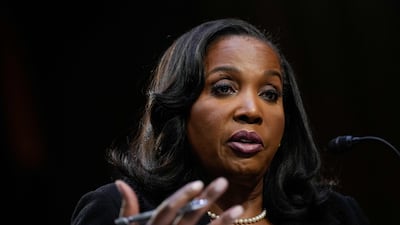The Federal Reserve could still achieve a soft landing by slowing down the US economy without driving it into a prolonged recession, although Fed governor Lisa Cook warned that the central bank runs the risk of doing too much or too little.
“I believe that a soft landing is possible, with continued disinflation and a strong labour market, but it is not assured,” she said at the Asia Economic Policy Conference in San Francisco.
Ms Cook noted the progress the Fed has made since it began its aggressive interest rate increases last year, when the Fed's preferred inflation gauge measured 7.1 per cent.
Chief among that progress is the latest reading of the personal consumption expenditures price index, which fell to 3.4 per cent in September.
The recovery of global supply chains and declines in global commodities such as Brent crude oil have contributed to moderating inflation, she said.
Labour market supply and demand is also showing signs of rebalancing, Ms Cook said.
Today, 1.5 job openings exist for every available worker, compared to 2.0 last year. This has come, she said, without a sharp rise in unemployment.
On the back of positive data, the Fed opted to keep interest rates steady at the 5.25 to 5.50 per cent range in October.
Now, the US central bank faces the dilemma of tightening too much or too little.
“I see risks as two-sided, requiring us to balance the risk of not tightening enough against the risk of tightening too much.”
Consumer spending and economic growth remain strong, which threaten the “pace of disinflation”, she said.
“But I am also attuned to the risk of an unnecessarily sharp decline in economic activity and employment,” Ms Cook said, pointing to lower-income households exhausting their savings.
She said this is complicated by other global banks engaging in tightening.
“Of course, when others are also tightening, each respective central bank may need to do a bit less to achieve the same outcomes because of these spillover effects,” Ms Cook said.
Complicating soft-landing hopes even further are potential global threats that could affect the US economy, such as China's weak economic growth.
Blackpink World Tour [Born Pink] In Cinemas
Starring: Rose, Jisoo, Jennie, Lisa
Directors: Min Geun, Oh Yoon-Dong
Rating: 3/5
Scoreline
UAE 2-1 Saudi Arabia
UAE Mabkhout 21’, Khalil 59’
Saudi Al Abed (pen) 20’
Man of the match Ahmed Khalil (UAE)
Signs%20of%20%20%20%20%20%20%20heat%20stroke
%3Cul%3E%0A%3Cli%3EThe%20loss%20of%20sodium%20chloride%20in%20our%20sweat%20can%20lead%20to%20confusion%20and%20an%20altered%20mental%20status%20and%20slurred%20speech%3C%2Fli%3E%0A%3Cli%3EBody%20temperature%20above%2039%C2%B0C%3C%2Fli%3E%0A%3Cli%3EHot%2C%20dry%20and%20red%20or%20damp%20skin%20can%20indicate%20heatstroke%3C%2Fli%3E%0A%3Cli%3EA%20faster%20pulse%20than%20usual%3C%2Fli%3E%0A%3Cli%3EDizziness%2C%20nausea%20and%20headaches%20are%20also%20signs%20of%20overheating%3C%2Fli%3E%0A%3Cli%3EIn%20extreme%20cases%2C%20victims%20can%20lose%20consciousness%20and%20require%20immediate%20medical%20attention%3C%2Fli%3E%0A%3C%2Ful%3E%0A
The five stages of early child’s play
From Dubai-based clinical psychologist Daniella Salazar:
1. Solitary Play: This is where Infants and toddlers start to play on their own without seeming to notice the people around them. This is the beginning of play.
2. Onlooker play: This occurs where the toddler enjoys watching other people play. There doesn’t necessarily need to be any effort to begin play. They are learning how to imitate behaviours from others. This type of play may also appear in children who are more shy and introverted.
3. Parallel Play: This generally starts when children begin playing side-by-side without any interaction. Even though they aren’t physically interacting they are paying attention to each other. This is the beginning of the desire to be with other children.
4. Associative Play: At around age four or five, children become more interested in each other than in toys and begin to interact more. In this stage children start asking questions and talking about the different activities they are engaging in. They realise they have similar goals in play such as building a tower or playing with cars.
5. Social Play: In this stage children are starting to socialise more. They begin to share ideas and follow certain rules in a game. They slowly learn the definition of teamwork. They get to engage in basic social skills and interests begin to lead social interactions.


